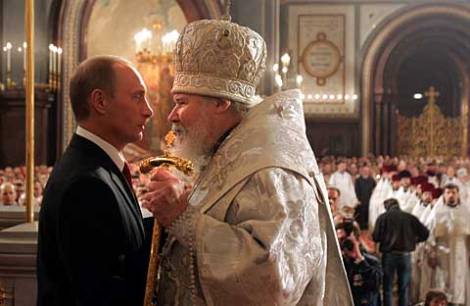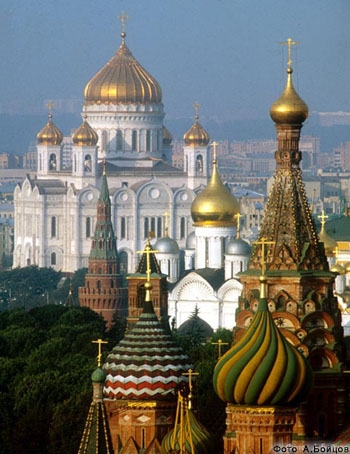 Only days after the fall of the Soviet Union, I had a chance to talk with several veteran Russian Orthodox priests about the future of their church in Russia.
It is crucial, one priest told me, for outsiders to be patient and to realize that it would be impossible for the Soviet era to simply end and for the church to change overnight. The painful, complex and often inspirational truth, he said, was that the new Russian had four kinds of bishops. As I wrote in a column for Scripps Howard:
Only days after the fall of the Soviet Union, I had a chance to talk with several veteran Russian Orthodox priests about the future of their church in Russia.
It is crucial, one priest told me, for outsiders to be patient and to realize that it would be impossible for the Soviet era to simply end and for the church to change overnight. The painful, complex and often inspirational truth, he said, was that the new Russian had four kinds of bishops. As I wrote in a column for Scripps Howard:
It's impossible to understand the modern Russian church, one said, without grasping that it has four different kinds of leaders. A few Soviet-era bishops are not even Christian believers. Some are flawed believers who were lured into compromise by the KGB, but have never publicly confessed this. Some are believers who cooperated with the KGB, but have repented to groups of priests or believers. Finally, some never had to compromise.
"We have all four kinds," this priest said. "That is our reality. We must live with it until God heals our church."
It's crucial to remember that all of this was taking place only a few generations after the Communists closed 98 percent of Russia's churches and, in one brief period, killed 200,000 bishops, priests and nuns and then sent another 500,000 believers to die in labor camps. Millions later died in Stalinist purges. KGB records indicate that most clergy were simply shot or hanged. But others were crucified on church doors, slaughtered on their altars or stripped naked, doused with water and left outdoors in winter.
The KGB records also contained evidence about clerics who yielded. Russian Orthodoxy was a complex mosaic of sin and sacrifice, during the era of the martyrs, and many scholars and journalists in the West were quick to focus on evidence of ties between the KGB and the Russian church's current leader, Patriarch Alexsy II.
The question many asked privately and, a few, openly: Precisely what kind of bishop was Alexsy II? To my surprise, these questions did not surface in the very muted obituary offered by the New York Times when the patriarch died on Friday. Here is a sample of the background material in the piece:
Aleksy II oversaw the largest Orthodox church in the world as the spiritual leader of more than 140 million people. He was the first leader of the church since the Bolshevik Revolution to be chosen without interference by the Soviet state, which had killed clergy members and believers and destroyed churches but which had allowed a church hierarchy to exist under tight control.
He rose to leadership in June 1990, days before Russia declared its sovereignty within the Soviet Union in the waning days of Mikhail Gorbachev's perestroika and just over a year before the August 1991 coup, a thwarted effort to restore Soviet rule. On Aug. 19, 1991, as tanks rolled into Moscow, the patriarch was leading a service on the Kremlin's Cathedral Square outside the Cathedral of the Dormition. Aleksy celebrated his last liturgy at the cathedral, on Thursday, the day before his death.
As patriarch, Aleksy II significantly deepened the church's role in everyday life in Russia, erecting and restoring cathedrals, introducing Orthodox religious education in public schools and becoming a prominent voice on moral issues.
More than anything else, the coverage on this side of the Atlantic has focused on the patriarch's ties, and perhaps friendship, with the all-powerful Vladimir V. Putin. We are told that Putin has openly confessed his Orthodox faith. We don't learn about the evidence of shared KGB ties.
 As you would expect, the coverage is deeper in Europe. Click here to head over to the two-story package in the Times of London. By the third paragraph of the main story, readers learn:
As you would expect, the coverage is deeper in Europe. Click here to head over to the two-story package in the Times of London. By the third paragraph of the main story, readers learn:
Alexiy II was elected head of the Orthodox Church in 1990 and oversaw its restoration to a dominant role in Russian society thanks to open support from the Kremlin under Boris Yeltsin and in particular Vladimir Putin, the former KGB officer.
Patriarch Alexiy's links with the Kremlin were clouded by allegations that he himself had been a long-serving KGB agent codenamed "Drozdov" (the thrush), who had been awarded a "certificate of honour" for his service by the Soviet authorities in 1988. He was accused of providing information on dissident priests, and the KGB even sent him to England in 1969 on a mission with a church delegation.
Yes, the accusations are serious. But the patriarch also talked, with some degree of candor, about the soul-wrenching compromises that church leaders were forced to make in the Soviet era.
How much did he confess to his priests and his brother bishops?
Meanwhile, there is another side of his public career and life story:
As Patriarch, Alexiy II oversaw the restoration of the Church's authority in Russia after the fall of Communism as churches were rebuilt and reopened across the country. He was seen as a unifying national figure,his moral strictures and benevolent appearance offering certainty at a time of extreme economic hardship and political upheaval.
Alexiy II also presided over a reunification ceremony at Christ the Saviour cathedral in Moscow last year that ended an 80-year schism with the Orthodox faithful whose families had fled Russia after the Bolshevik Revolution in 1917.
His death after an 18-year reign is likely to prompt an outpouring of grief in Russia, which has experienced a profound religious revival since the collapse of the Soviet Union.
So what kind of bishop was Patriarch Alexsy II? God knows. It is likely that more evidence will emerge and, no matter their opinions, the faithful will pray: Memory eternal.
PHOTO: Pascha, 2007, with Putin.
